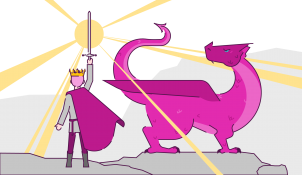Asking the right questions can be key to writing and deploying a winning sales presentation. But what questions should you ask when writing your presentation outline?
I spend a lot of my time with clients helping them to craft persuasive sales presentations. We begin by creating a presentation outline. When I ask the right questions – and clients really think about the right answers – the process runs like a dream. So, if you’ve been wondering how to write a presentation that will impress colleagues and clients alike, this is a great place to start.
Here are the top 10 questions to ask when you start writing a presentation outline. Many of them will be worth asking whenever you start to think about your sales messaging.
Presentation outline already sorted? Pick up some more tips on creating better sales presentations or discover awesome PowerPoint tricks with our free online resources.
1. Who will the presentation be delivered to, and by whom?
It makes a difference. What are the audience members looking for? What are their roles? What personally do they stand to gain or lose? Are they focused on savings, performance, ease of use?
Will your presenters be able to explain your complex messages confidently, or do you have to make things easier for them? Do your sales people sell a large number of products, or are they completely focused on yours?
2. What challenges do your prospects face that you address?
One of the most important questions for writing a winning sales presentation. You need to really understand the prospect’s situation. Don’t just tell the prospect what your solution does, but why they might want it. Paint a picture of the problems they are having, and all the implications of those problems. Build empathy by showing you understand their situation, and exploit the fact that their current situation isn’t perfect.
3. Who are you competing with in trying to make this sale?
Has the prospect decided to change, or are you competing with the status quo and inertia? Are you competing with a DIY approach and the people inside the company who are currently proud of their own efforts? Are you competing with other companies approaching things in the same way, or even in a completely different way? It’s no use explaining why you are better than a competitor if you are competing against the fear of change and the prospect isn’t really sure they have a problem. Understanding this question is essential and the answer will dramatically affect your presentation outline.
4. What will stop your prospects overcoming these challenges if they take a different approach to solving their problems?
Basically, why won’t putting more energy into their current approach work? Why won’t competing solutions work? What’s wrong with them? This is a chance to teach your audience something. If there’s something inherently flawed with alternative approaches, work it out and teach your prospects.
5. Why should prospects choose you?
Your sales presentation outline should answer the simple question, What makes your approach special? What are the key advantages that your solution offers? What things that your prospects care about really set you apart? Brainstorm answers to this question, and for each idea, ask yourself: Do prospects care about this? Can prospects be made to care about this? Is this more than ‘table stakes’ – something we have to have, but not something we’re evaluated on? Do we have competitive advantage in this area?
6. What objections or misconceptions do you need to overcome?
If prospects see your company or solution in the wrong way, it’s worth anticipating and doing something about it. Not every misconception is raised directly – sometimes people assume the worst and switch off. Finding out what objections you face in the field helps to suggest lines of reasoning to use in your sales presentation.
7. How can you demonstrate you offer the advantages and benefits that you claim to offer?
How does your solution work? What statistics, independent reviews, testimonials, case studies, and awards will help to back up your story to make it convincing? Include all this evidence in your presentation outline – you can refine it later.
8. What’s the concrete next step you want prospects to take as a result of your presentation?
Are you trying to be hired or short-listed? If you just need to be short-listed, it can be enough to explain that you offer something different from others. Are you selling a contract or giving away a trial? If you are just trying to sell a trial, you can emphasise that there’s little risk to the client.
When considering how to write a presentation, remember that your messaging needs to match your objectives.
9. How can you eliminate bullet points to create compelling slides that help presenters get your message across?
Even with the best messaging in the world, if your presenters can’t get your point across you’re in trouble. Bullet points don’t work, because the audience will ignore your presenters while they read the slides, then switch off. Slides that look good on SlideShare don’t work because they are self-explanatory and make your sales people unnecessary. ‘Death by PowerPoint’ is no way to sell. What visuals will help your presenters communicate your message, without making them surplus to requirements? Great slide design is key – read our how-to on great visual slides here.
10. How can you make sure your presenters actually adopt your new presentation outline?
Will sales people and marketing sit down together to create the new sales tools you need (a real key area for sales and marketing alignment)? Will you provide a recorded version of the presentation for reference? Will you provide presentation skills training for sales people? If nobody uses the new sales presentation, it’s not going to be much use.
Once you have answered these questions, you’ll have an awesome presentation outline that includes everything you need to impress your clients and achieve your goals. Seeking more expert advice? Take a look at our guide on how to write the ULTIMATE sales presentation.
Leave a comment





Great post, thank you! I’ve seen too many sales presentations that have veered off topic, made little impact, or seemed to be put together without much forethought. I’d add another question to list; “What presentation style/technology will help me connect with my audience?”
You’re absolutely right in what you say! 🙂
My approach is more philosophical (so to speak!). It’s simply this: ask yourself, for every sentence or slide – from the audience’s point of view “What’s In It For Me?”!
S
@Circle Tech, yes, great point. You could probably use the plural – there’s no reason to use a single technology – switching between slides, sketches, and 3D props can work brilliantly in a sales presentation.
@Simon, yes, of course that’s an important question and we always need to be mindful of it when we write sales messaging. But it’s not sufficient. Imagine that you are selling print advertising for the FT. What’s in it for your prospects – greater brand awareness, and maybe more leads. Why should I buy from the FT and not Google AdWords? Well, that’s not answered by WIIFM, because competitors can deliver the same benefits in different ways (and to different extents). So yes, of course a sales presentation needs to be couched in terms of benefits for the audience, but that’s not sufficient to help you write it.